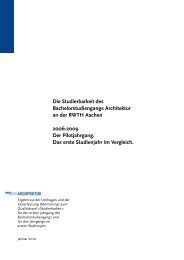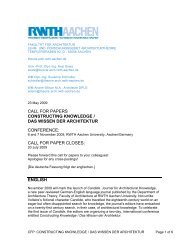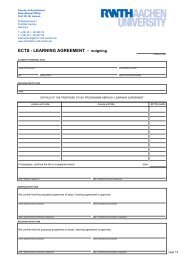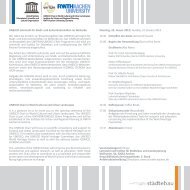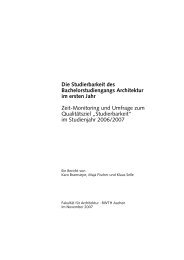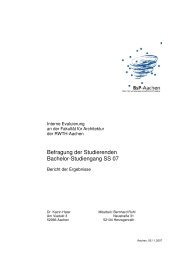Gutachten Dresden_englisch_dritte f.indd - Fakultät für Architektur ...
Gutachten Dresden_englisch_dritte f.indd - Fakultät für Architektur ...
Gutachten Dresden_englisch_dritte f.indd - Fakultät für Architektur ...
You also want an ePaper? Increase the reach of your titles
YUMPU automatically turns print PDFs into web optimized ePapers that Google loves.
112<br />
At the same height as the Waldschlösschen are the broadest local expanses of the Elbe<br />
meadows and the peak of the Elbe river bend, its median point between Altstadt and<br />
Loschwitz. It is from this point that two emblems of <strong>Dresden</strong> are visible: the city skyline<br />
with the restored Frauenkirche, as well as that engineering marvel of the Elbe Valley,<br />
the “Blue Wonder” bridge.<br />
The position of the vantage point at Waldschlösschen, in the middle of the Elbe river<br />
bend, contributes to the feeling of open space, while both distant landmarks make a<br />
combined visual impression. The distances to the Frauenkirche and to the Loschwitz<br />
Bridge are combined in the mind of the viewer. For this effect to take place, the spatial<br />
context of the valley and floodplain must be undisturbed.<br />
Exactly at this point, that is, at the vertex of the bend, is where the Waldschlösschen<br />
Bridge would create a break in the view of the landscape, a split into two almost equally<br />
sized areas, but which could not be visually recombined to create a whole. The sense<br />
of space would be destroyed; it would be lost over the long term, thereby effacing<br />
this particular experience of landscape. Any bridge is more than just a stroke within<br />
a landscape. When a landscape is truly appreciated, our visual, acoustic, and tactile<br />
sense-perceptions are all stimulated. Thus, the sounds of bird song or of water flowing<br />
heighten a person’s experience of a landscape. But by the same token, it is not difficult<br />
to imagine that the effect of an optical split of the Elbe Valley would be exacerbated by<br />
the noise of a four-lane bridge.<br />
Based on these considerations, from the point of view of this report, the only conclusion<br />
which can be made is that the visual impact of the projected Waldschlösschen Bridge<br />
would be severe. In terms of the limited scope of the question under investigation, the<br />
conclusion even has to be drawn that building the bridge in this place would irreversibly<br />
damage the unique qualities of the Elbe Valley.<br />
Until now, the planning process has been marked by a series of unfortunate circum-<br />
stances. The fact that the projected building date of the Waldschlösschen Bridge and<br />
the application procedure for the <strong>Dresden</strong> Elbe Valley’s inclusion in the World Heritage<br />
Site list have overlapped in time has created a situation where productive dialogue<br />
towards an acceptable solution has become difficult. The citizens’ decision to approve<br />
the project, taken together with the legal situation following the court decision, have<br />
resulted in additional circumstances which constrain the discussion of alternatives to the<br />
“Verkehrszug Waldschlösschenbrücke”, particularly since the financial and legal impli-<br />
cations of the advertised project are considerable. However, these are primarily political<br />
factors, and as such must not be included in the assessor‘s report.





